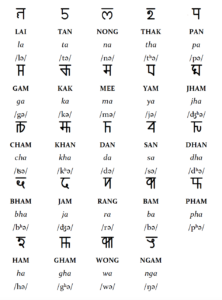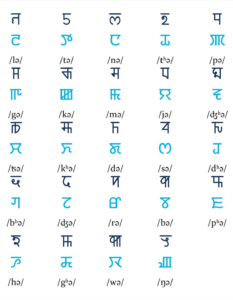Meetei (or Meitei) Mayek was not the only effort to revive and reintroduce the ancient Meitei script, banned and burned in the eighteenth century.
To recap: until the end of the seventeenth century, the people of the Meitei kingdom in northeast India followed a traditional faith whose holy texts, called puya, were written in Meetei (or Meitei) script. After King Charairongba was converted to Vaishnavism, a sect of Hinduism, in 1704 and his son King Pamheiba (1709-1748) also converted himself to Vaishnavism, the latter declared Hinduism as the state religion and renamed the kingdom as Manipur. He declared Bengali script as the official script for the Meitei language and introduced Bengali and Sanskrit. Puyas were burned and replaced by Bengali and Sanskrit texts.
Biswajit Mandal takes up the story in his proposal to include Meetei Yelhou Mayek in the Unicode standard.
More than a century later, Laininghan (Prophet) Naoriya Phulo, a Meitei religious, social and political leader, was born on 28 August 1888 in Laishram Khul Mayai Leikai, Assam. He founded a Meitei religion revivalist school named Apokpa Marup in 1930 at Cachar, Assam, aiming to preserve traditional Meitei customs and revive the suppressed old Meitei faith.
As with all almost-completely-eradicated scripts, one major challenge is to gather examples of the symbols, preferably along with their context—a challenge made harder if the original written form used a fragile medium such as paper.
Laininghan Naoriya Phulo pursued an interesting and unusual research strategy. As it happens, Mandal reports, Meitei has seven clans, and the head of each clan, or sagei pibas, traditionally created bronze coinage to be used in rituals—and the coins bore inscriptions in the old Meitei script.
Laininghan Naoriya Phulo collected inscribed coins from every sagei pibas, studied them, and used this source to reintroduce the script, which he called as Meetei Yelhou Mayek, yelhou meaning “primordial” or “aboriginal” and mayek meaning “script.”
He used this script to revive their traditional faith, Apokpa Laining, and rewrote the holy texts in Meetei Yelhou Mayek, replacing the Bengali script. He also rewrote the holy book Shakok Thiren, based on the cosmic evolution of the Meitei mythology, in Meetei Yelhou Mayek.
When the modernized version of Meetei Mayek was approved by Manipur State law for use in educational institutions in 1980, followers of the Apokpa Laining faith (who live mostly in Assam) continued to use the Meetei Yelhou Mayek in their rituals and worship, along with Bengali-Assamese script. They teach the script in religious schools and temples as part of the spiritual training, and while there are reportedly no textbooks published in the script, but there are some primers and multiple religious or philosophical books published in it, and even one newspaper.

